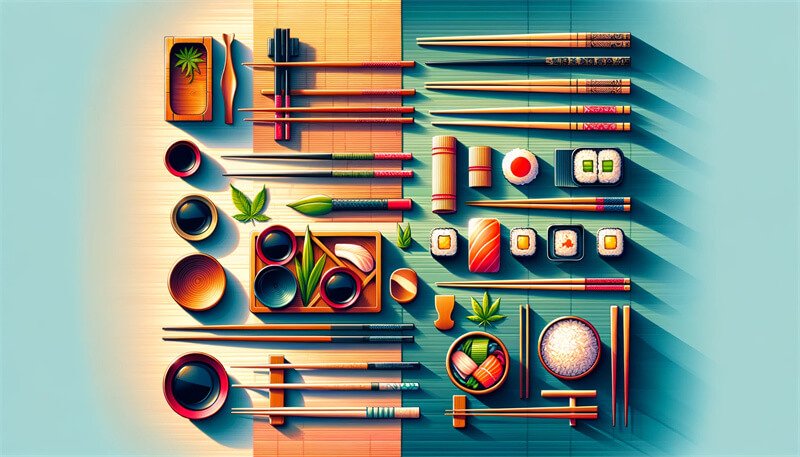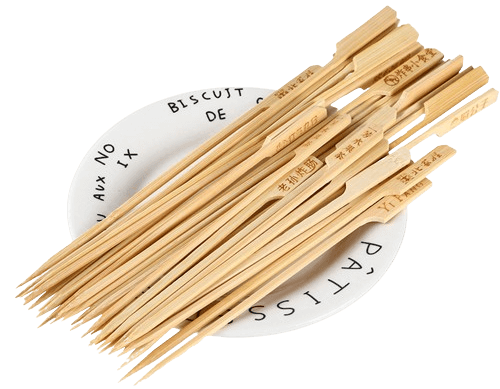At Ecostix Global, our mission is to revolutionize the way the world sees bamboo products. We strive to create high-quality, sustainable bamboo chopsticks and sticks that are not just utensils but symbols of a more eco-conscious lifestyle. Our focus is on blending traditional craftsmanship with modern innovation to produce items that are both environmentally friendly and aesthetically pleasing. We aim to inspire a shift towards sustainable practices in everyday life, making a positive impact on the environment while serving the practical needs of our customers.
Key Takeaways
| Aspect | Chinese Chopsticks | Japanese Chopsticks |
|---|---|---|
| Origins | Originated over 3,000 years ago in ancient China. | Introduced to Japan from China, with use recorded since the 10th century. |
| Design and Dimensions | Typically longer (around 25 cm), thicker, with blunt ends. Made from bamboo, wood, plastic, metal. | Shorter (around 20-23 cm), taper to a point. Made from bamboo, wood, often lacquered. |
| Cultural Significance | Shorter (around 20-23 cm), taper to a point. Made from bamboo, and wood, often lacquered. | Personalized for individual use. Have ceremonial uses, such as offerings to the dead. |
| Etiquette | Focus on practicality, less individualized. | Detailed etiquette rules, including proper holding and resting positions. |
| Modern Adaptations | Variety of materials, influenced by modern dining needs. | Increased use of reusable chopsticks due to environmental concerns. |
Introduction
Chopsticks are more than just eating utensils; they are cultural symbols with rich histories and distinctive characteristics. At Ecostix Global, we believe in the power of bamboo to create sustainable, high-quality chopsticks that honor these traditions while promoting an eco-friendly lifestyle. This article explores the origins and differences between Japanese and Chinese chopsticks, helping you understand their unique features and cultural significance.
Historical Origins
Chinese Origins
Chopsticks originated in China over 3,000 years ago, evolving from cooking utensils to essential dining tools. Their long history is deeply intertwined with Chinese culinary practices and social customs. Early chopsticks were used primarily for cooking and serving food, gradually becoming common dining implements as communal meals became popular. This evolution reflects the adaptability and cultural significance of chopsticks in Chinese society.
Japanese Adoption
Chopsticks were introduced to Japan via China, with their use recorded as early as the 10th century. Initially, they were used in religious ceremonies before becoming everyday utensils. Japanese chopsticks have evolved significantly over the centuries, influenced by various cultural and historical factors. Today, they are an integral part of Japanese dining culture, reflecting both tradition and modernity.
Design and Material Differences
Chinese Chopsticks
Chinese chopsticks are typically longer, around 25 cm, and thicker with blunt ends. They are made from a variety of materials, including bamboo, wood, plastic, and metal. The design of Chinese chopsticks varies across regions, often reflecting local customs and culinary needs. For instance, chopsticks used in seafood-rich areas may be designed to handle slippery items more efficiently.
Japanese Chopsticks
Japanese chopsticks are shorter, usually between 20-23 cm, and taper to a fine point. They are traditionally made from bamboo or wood and often feature a lacquer finish. Japanese chopsticks are designed for precision, making them ideal for handling delicate foods like sushi. Their design also includes variations for different types of meals, such as longer chopsticks for cooking and shorter ones for individual use.
Cultural Significance and Usage
Chinese Cultural Practices
In Chinese culture, chopsticks are more than just utensils; they are extensions of one’s fingers, used to reach and pick up food in communal dining settings. This practicality is essential in Chinese cuisine, which often involves sharing multiple dishes placed at the center of the table. Chinese chopsticks also play a role in various traditional customs and ceremonies, highlighting their cultural importance.
Japanese Cultural Practices
In Japan, chopsticks are highly individualized, with each person typically having their own pair. This personalization extends to ceremonial uses, such as placing chopsticks upright in a bowl of rice as offerings to the dead. Japanese dining etiquette includes detailed rules on how to properly use and handle chopsticks, reflecting the cultural significance and respect associated with these utensils.
Learn more about our commitment to sustainable bamboo products.
Practical Applications and Modern Adaptations
Chinese Chopsticks
Chinese chopsticks are versatile and adapted to modern dining needs, with materials ranging from traditional bamboo and wood to modern plastic and metal. These adaptations make them suitable for various cuisines and dining environments, reflecting the global influence of Chinese culinary traditions.
Japanese Chopsticks
Japanese chopsticks have also evolved to meet modern needs, with an increased emphasis on reusable materials due to environmental concerns. The use of lacquered wood and other sustainable materials aligns with the growing trend towards eco-friendly dining practices. This shift reflects the broader movement towards sustainability in everyday life, a value that Ecostix Global champions through our bamboo products.
Practical Applications and Modern Adaptations
Chinese Chopsticks
Chinese chopsticks are known for their versatility and durability, making them suitable for various dining scenarios. Traditionally made from materials like bamboo and wood, modern adaptations include plastic and metal chopsticks, catering to different preferences and uses. The longer and thicker design of Chinese chopsticks makes them ideal for communal dining, allowing diners to easily reach shared dishes on a rotating table, a common feature in Chinese restaurants.
In modern times, the global spread of Chinese cuisine has led to the widespread use of Chinese-style chopsticks in various countries. This has facilitated cultural exchange and increased awareness of Chinese dining customs. Additionally, the durability and practicality of Chinese chopsticks have made them popular in both casual and formal dining settings, emphasizing their role in promoting sustainable dining practices.
Explore our selection of bamboo chopsticks designed for durability and sustainability.
Japanese Chopsticks
Japanese chopsticks have evolved to reflect the unique culinary practices and aesthetics of Japan. Known for their shorter length and tapered ends, Japanese chopsticks are designed for precision, making them perfect for handling delicate foods like sushi and sashimi. The use of lacquered wood and intricate designs adds an element of artistry, turning these chopsticks into cultural symbols as well as functional tools.
The shift towards sustainability in Japan has led to an increased focus on reusable chopsticks. Many Japanese households now use durable, eco-friendly materials, reducing the reliance on disposable options. This change aligns with global environmental trends and highlights the importance of sustainable practices in everyday life. At Ecostix Global, we are proud to offer high-quality bamboo chopsticks that combine traditional craftsmanship with modern sustainability.
Learn more about the care and maintenance of reusable bamboo chopsticks.
Etiquette and Handling
Chinese Etiquette
Chinese dining etiquette emphasizes practicality and respect. Key points to remember include:
- Holding Position: Hold chopsticks towards the back end for better control.
- Do Not Spear Food: Avoid spearing food with chopsticks, as this is considered impolite.
- Resting Position: Place chopsticks horizontally across your plate or on a chopstick rest when not in use.
- Communal Dining: Use serving chopsticks or the opposite ends of your chopsticks to take food from communal dishes.
Understanding these etiquette rules can enhance your dining experience and show respect for Chinese culture.
Discover more about Chinese chopstick etiquette and its significance.
Japanese Etiquette
Japanese chopstick etiquette is detailed and rooted in tradition. Some key practices include:
- Proper Holding: Hold chopsticks towards their back end, not in the middle or front.
- Avoid Pointing: Do not point with chopsticks or wave them around.
- Separating Food: Exert controlled pressure to separate food without flicking it.
- Passing Food: Do not pass food directly from your chopsticks to someone else’s, as this mimics funeral rites.
- Resting Position: Use a chopstick rest or fold the paper sleeve to create a rest when placing chopsticks down.
These etiquette practices reflect the deep cultural significance of chopsticks in Japan and help ensure a respectful dining experience.
Master the art of using Japanese chopsticks with our comprehensive guide.
Conclusion
Understanding the differences between Japanese and Chinese chopsticks enriches our appreciation of these unique utensils. At Ecostix Global, we believe in the power of bamboo to create sustainable, high-quality chopsticks that honor these traditions while promoting an eco-friendly lifestyle. Whether you are exploring the cultural significance, practical applications, or modern adaptations of chopsticks, our products are designed to meet your needs while supporting a sustainable future.
Shop our range of eco-friendly bamboo chopsticks and join us in making a positive impact on the environment through thoughtful, sustainable choices.
FAQs
What are the main differences between Chinese and Japanese chopsticks?
Chinese chopsticks are typically longer, thicker, and have blunt ends, while Japanese chopsticks are shorter, taper to a point, and often feature lacquered designs.
How do Chinese and Japanese chopsticks reflect their respective cultures?
Chinese chopsticks are designed for communal dining and practicality, whereas Japanese chopsticks are individualized and often used with detailed etiquette practices.
Can bamboo chopsticks be reused?
Yes, bamboo chopsticks can be reused if they are properly cared for. Reusable bamboo chopsticks are durable and environmentally friendly, making them a sustainable choice for everyday use.
Learn more about reusability and care of bamboo chopsticks.
Continue exploring the fascinating world of chopsticks and their cultural significance. Visit our website to learn more about our sustainable bamboo products and how they can enhance your dining experience while supporting an eco-friendly lifestyle.



